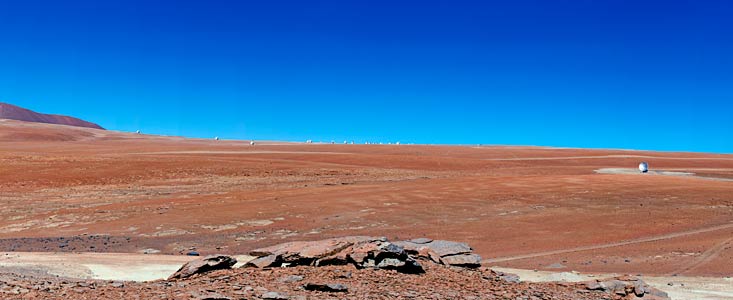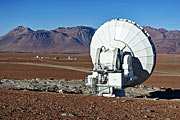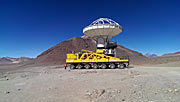Announcement
ALMA Extends Its Arms
Longest ALMA baseline yet achieved
24 September 2014
The Atacama Large Millimeter/submillimeter Array (ALMA) has successfully tested an antenna in the most extended configuration of the array yet, producing the longest baseline ever achieved by ALMA. This advance became possible once the first of ALMA's three extended arms was successfully powered up for the first time, and opens up the possibility of greatly extending ALMA’s capabilities. With longer baselines, the ability of a radio telescope to see fine detail increases, allowing astronomers to uncover much more information about objects observed in the Universe.
Lore, one of ALMA’s two tailor-made antenna transporters, made its first journey along the Pampa la Bola arm and for the first time relocated an antenna to a position seven kilometers away from its furthest neighbour. This marks a major new technical achievement in the Atacama Desert in Chile, at more than 5000 metres above sea level. This new baseline is more than four times longer than is currently available to the ALMA scientific community, and tests of even longer baselines are in progress.
Catherine Vlahakis, Lead Program Scientist for the ALMA Long Baseline Campaign says that: "successfully powering up an antenna for the first time over these long distances marks an important technical step towards increasing ALMA's ability to see objects in the Universe in fine detail".
Ed Fomalont, Lead Scientist for the ALMA Long Baseline Campaign, explains that "the combination of the signals from the antennas produces patterns called fringes. The fringes measured from the antenna seven kilometres away were as pure and strong as will be needed to obtain high quality images when additional antennas are moved to these long baselines."
Catherine Vlahakis, adds that "this is the first step in a process of moving several antennas out to these longer distances. Once the rest of the antennas are also in place we will be able to begin test observations of astronomical objects at higher angular resolution, and therefore in more exquisite detail, than ALMA has yet achieved."
Observations that will further test extended configurations of the array will continue over the next two months. If all goes as intended, this process will provide astronomers with the knowledge needed to offer long-baseline observations to the scientific community.
Contacts
Lars Lindberg Christensen
Head of ESO ePOD
Garching bei München, Germany
Tel: +49 89 3200 6761
Cell: +49 173 3872 621
Email: lars@eso.org
About the Announcement
| Id: | ann14069 |
Our use of Cookies
We use cookies that are essential for accessing our websites and using our services. We also use cookies to analyse, measure and improve our websites’ performance, to enable content sharing via social media and to display media content hosted on third-party platforms.
ESO Cookies Policy
The European Organisation for Astronomical Research in the Southern Hemisphere (ESO) is the pre-eminent intergovernmental science and technology organisation in astronomy. It carries out an ambitious programme focused on the design, construction and operation of powerful ground-based observing facilities for astronomy.
This Cookies Policy is intended to provide clarity by outlining the cookies used on the ESO public websites, their functions, the options you have for controlling them, and the ways you can contact us for additional details.
What are cookies?
Cookies are small pieces of data stored on your device by websites you visit. They serve various purposes, such as remembering login credentials and preferences and enhance your browsing experience.
Categories of cookies we use
Essential cookies (always active): These cookies are strictly necessary for the proper functioning of our website. Without these cookies, the website cannot operate correctly, and certain services, such as logging in or accessing secure areas, may not be available; because they are essential for the website’s operation, they cannot be disabled.
Functional Cookies: These cookies enhance your browsing experience by enabling additional features and personalization, such as remembering your preferences and settings. While not strictly necessary for the website to function, they improve usability and convenience; these cookies are only placed if you provide your consent.
Analytics cookies: These cookies collect information about how visitors interact with our website, such as which pages are visited most often and how users navigate the site. This data helps us improve website performance, optimize content, and enhance the user experience; these cookies are only placed if you provide your consent. We use the following analytics cookies.
Matomo Cookies:
This website uses Matomo (formerly Piwik), an open source software which enables the statistical analysis of website visits. Matomo uses cookies (text files) which are saved on your computer and which allow us to analyze how you use our website. The website user information generated by the cookies will only be saved on the servers of our IT Department. We use this information to analyze www.eso.org visits and to prepare reports on website activities. These data will not be disclosed to third parties.
On behalf of ESO, Matomo will use this information for the purpose of evaluating your use of the website, compiling reports on website activity and providing other services relating to website activity and internet usage.
Matomo cookies settings:
Additional Third-party cookies on ESO websites: some of our pages display content from external providers, e.g. YouTube.
Such third-party services are outside of ESO control and may, at any time, change their terms of service, use of cookies, etc.
YouTube: Some videos on the ESO website are embedded from ESO’s official YouTube channel. We have enabled YouTube’s privacy-enhanced mode, meaning that no cookies are set unless the user actively clicks on the video to play it. Additionally, in this mode, YouTube does not store any personally identifiable cookie data for embedded video playbacks. For more details, please refer to YouTube’s embedding videos information page.
Cookies can also be classified based on the following elements.
Regarding the domain, there are:
- First-party cookies, set by the website you are currently visiting. They are stored by the same domain that you are browsing and are used to enhance your experience on that site;
- Third-party cookies, set by a domain other than the one you are currently visiting.
As for their duration, cookies can be:
- Browser-session cookies, which are deleted when the user closes the browser;
- Stored cookies, which stay on the user's device for a predetermined period of time.
How to manage cookies
Cookie settings: You can modify your cookie choices for the ESO webpages at any time by clicking on the link Cookie settings at the bottom of any page.
In your browser: If you wish to delete cookies or instruct your browser to delete or block cookies by default, please visit the help pages of your browser:
Please be aware that if you delete or decline cookies, certain functionalities of our website may be not be available and your browsing experience may be affected.
You can set most browsers to prevent any cookies being placed on your device, but you may then have to manually adjust some preferences every time you visit a site/page. And some services and functionalities may not work properly at all (e.g. profile logging-in, shop check out).
Updates to the ESO Cookies Policy
The ESO Cookies Policy may be subject to future updates, which will be made available on this page.
Additional information
For any queries related to cookies, please contact: pdprATesoDOTorg.
As ESO public webpages are managed by our Department of Communication, your questions will be dealt with the support of the said Department.




